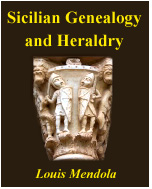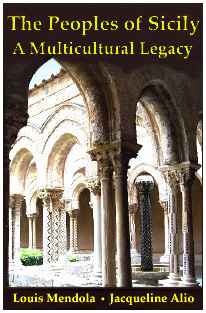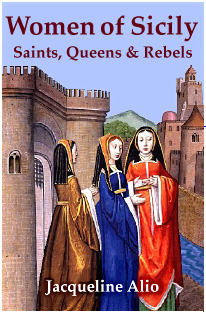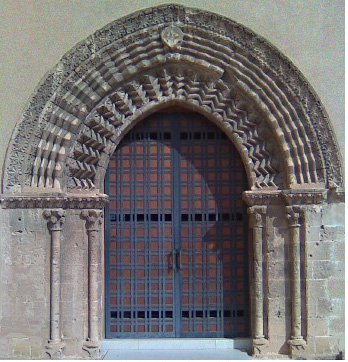...Best of Sicily presents... Best of Sicily Magazine. ... Dedicated to Sicilian art, culture, history, people, places and all things Sicilian. |
by Vincenzo Salerno | ||
Magazine Index Best of Sicily Arts & Culture Fashion Food & Wine History & Society About Us Travel Faqs Contact Map of Sicily
|
With the growing interest in family history - particularly in the US and the UK - it's worth considering the question of Sicilian genealogy for those in the "Sicilian diaspora," the descendants of Sicilians around the world. The good news is that Sicily has the best, most complete genealogical records in the world, meaning that the majority of "ordinary" (non-aristocratic) Sicilians can trace a lineage to circa 1500. (Here "majority" means more than fifty percent but, realistically speaking, not ninety percent.) European genealogists like to talk about the first Catholic parochial (church) records of baptisms, marriages and deaths beginning around the time of the Council of Trent in 1545. The problem is that in England (where the first were recorded in 1538), Ireland, France and the German states these have not always been preserved, while in Sicily they usually have been - barring a catastrophe like a church burning down or the registers being damaged by water or eaten by hungry country mice. What is more, some Catholic parishes in Sicily actually began recording these acts decades before 1545, as early as the latter years of the fifteenth century. The reality is that in most countries you are unlikely to find a record of this kind before 1600, and in fact it is quite exceptional to find one for the years before 1700. In Orthodox Europe (Russia, Greece, Romania, etc.) the parochial acts are rarely preserved for periods before 1800. Yes, there are occasional exceptions to these generalities, and with luck you'll encounter one if you're researching in those countries. Sicilian Jewish genealogy presents special challenges; by 1500 most Sicilians were Roman Catholic, though a few Albanian immigrant parishes belonged to the Byzantine Rite and recorded their earliest parochial acts in Greek. An interesting point here is that in Sicily the names and surnames of many medieval Jews (and Christian converts or anusim after 1493) are known, while in central and eastern Europe few Jewish families even had hereditary surnames before being ordered to assume them by the Russian and Austrian emperors circa 1800. Civil records (vital statistics acts of birth, marriage and death) were widely instituted in Europe during the nineteenth century, but here again inception varies greatly from one place to another. In southern peninsular Italy the first ones date from 1809. The first in Sicily are in 1820 (in most of northern Italy they began circa 1865). For comparison, in England the vital statistics records began in 1837, and in 1855 in Scotland and in 1864 in Ireland. But in practice a Sicilian marriage record from 1820 may be much more useful than its date implies because it may include marriage contract documents called processetti matrimoniali, attachments such as baptism certificates of the spouses and information about their parents, and this can extend a lineage well into the eighteenth century. The Sicilian vital records also list occupations and places of residence and some contain ancestors' signatures. Civil records before 1860 list the subject's parish, thereby giving the genealogist a good idea of where to pursue the next phase of research into the past. Census records are very important. These took various forms and in most of Europe they were extremely rare before the eighteenth century. The earliest one conserved in England is from 1841, the country's first ever being taken in 1801. In Sicily the principal census record is the rivelo (somewhat similar to the catasti of other regions), which is chiefly a land tax record that lists homes, each registrant's parentage, spouse and children. Everybody is listed, even if all he owned was a house or a horse. Here is where the records of the Kingdom of Sicily shine. This state existed in some form from 1130 to 1860, and a detailed rivelo was taken every few decades from the end of the fifteenth century into the nineteenth century. These have been preserved in a central archive, and genealogists sometimes consult them to fill in the blanks for an early period during which a parochial record does not exist - for example in a town founded in the Middle Ages but whose parish church records were destroyed in 1700. In practice, the riveli are much more than complementary information; they list land owned (with its general location) and sometimes provide an indication of citizens' social status or professions. Contrary to the myth about "landless peasants," most of the people listed in the riveli of the Kingdom of the Two Sicilies, the most prosperous state of pre-unitary Italy, owned a house and at least a tiny parcel of land. Notary records are notoriously difficult to research, generally being unindexed and catalogued according to the name of the notary rather than by locality. As notaries were not limited by geographical jurisdiction, any notary could notarize any act anywhere in Sicily. Yet notaries certified land purchases, dowries and wills, and their acts, preserved at Palermo's state archive, span over five centuries. Land records take various forms. While they are typically identified with research on aristocratic lineages, the feudal records are worth mentioning because until the abolition of feudalism in 1812 most land - even small plots owned by ordinary people - was identified by the manor (fief) in which it was located. Typically, a town might have from a dozen to thirty manors of varying size surrounding it, and some modern frazioni and contrade are contiguous to these territories, bearing the names of the manors they once were. The earliest feudal compendia (comprehensive rolls) date from the Norman era, and England's Domesday Book (completed in 1086) is the best known. The Catalogus Baronum was compiled in 1150 during the Kingdom of Sicily's Norman period but the surviving copy only covers peninsular southern Italy. For Sicily itself, the so-called Roll of Muscia was compiled in 1296. At issue is the question of preservation of documents recording continuous feudal succession, from one owner to the next, over the centuries. In Sicily these records date from circa 1458 (in some cases earlier) until 1812 and are retained in a central public registry, with basic details published in book form in the twentieth century. In most cases, establishing a historical chain of ownership of feudal property over several centuries is not too difficult. This makes identifying historical possession of feudal lands (manors, baronies, counties, etc.) in the Kingdom of Sicily a fairly straightforward process, and it is not at all unusual to consult actual, original feudal land transfer documents dating from 1500. Although England's earliest extant feudal record, Domesday Book, pre-dates Sicily's Roll of Muscia by two centuries, that nation's public depository (H.M. Land Registry) was established only in 1862, and many English feudal records are still in private hands (in formats such as the "pipe rolls"). This sometimes complicates the identification of legitimate holders of the manorial lordships mentioned in Domesday Book. No such problems await Sicilian researchers. There are other records. While in Sicily few of the libri memoriales of the monasteries have been preserved, a few parishes have lists of parishioners going back to an early date, and there are, of course, published compilations of medieval pedigrees. Our Sicilian genealogy page offers some advice on conducting family history research here in Sicily. About the Author: Vincenzo Salerno has written for various publications and authored several books published in Italian. | |
Top of Page |



